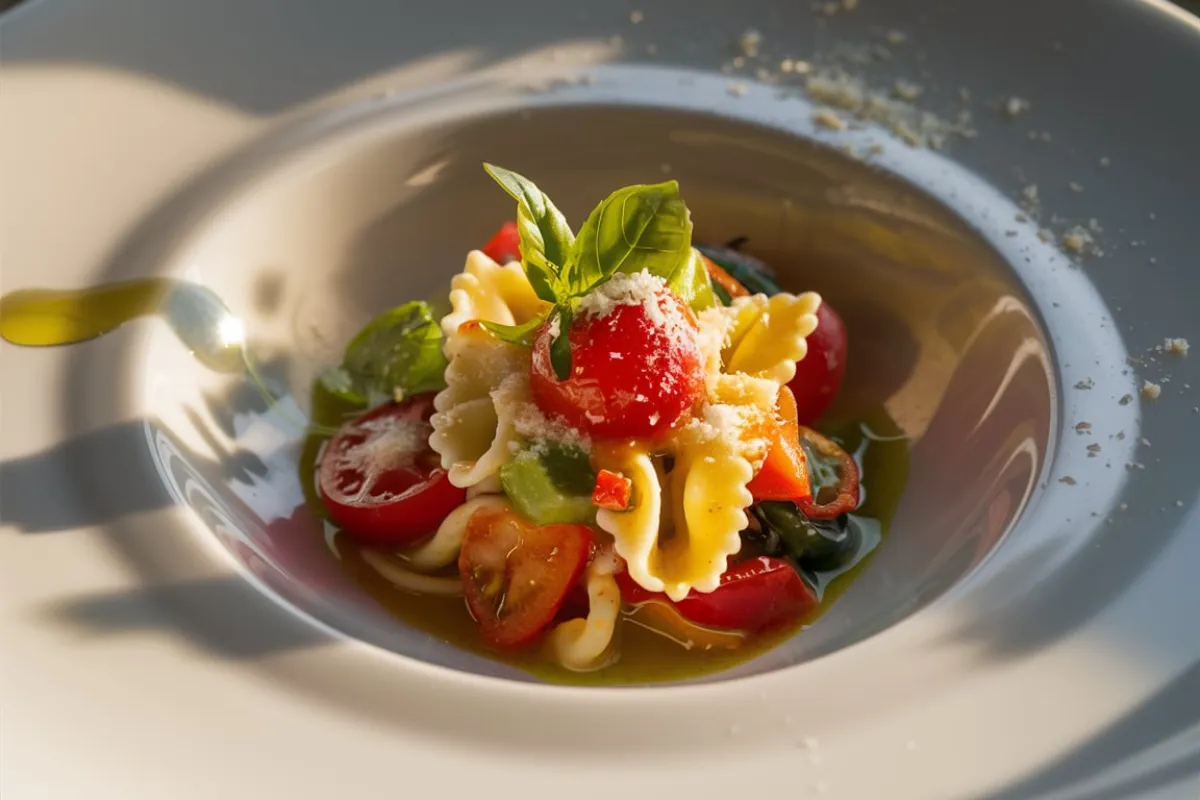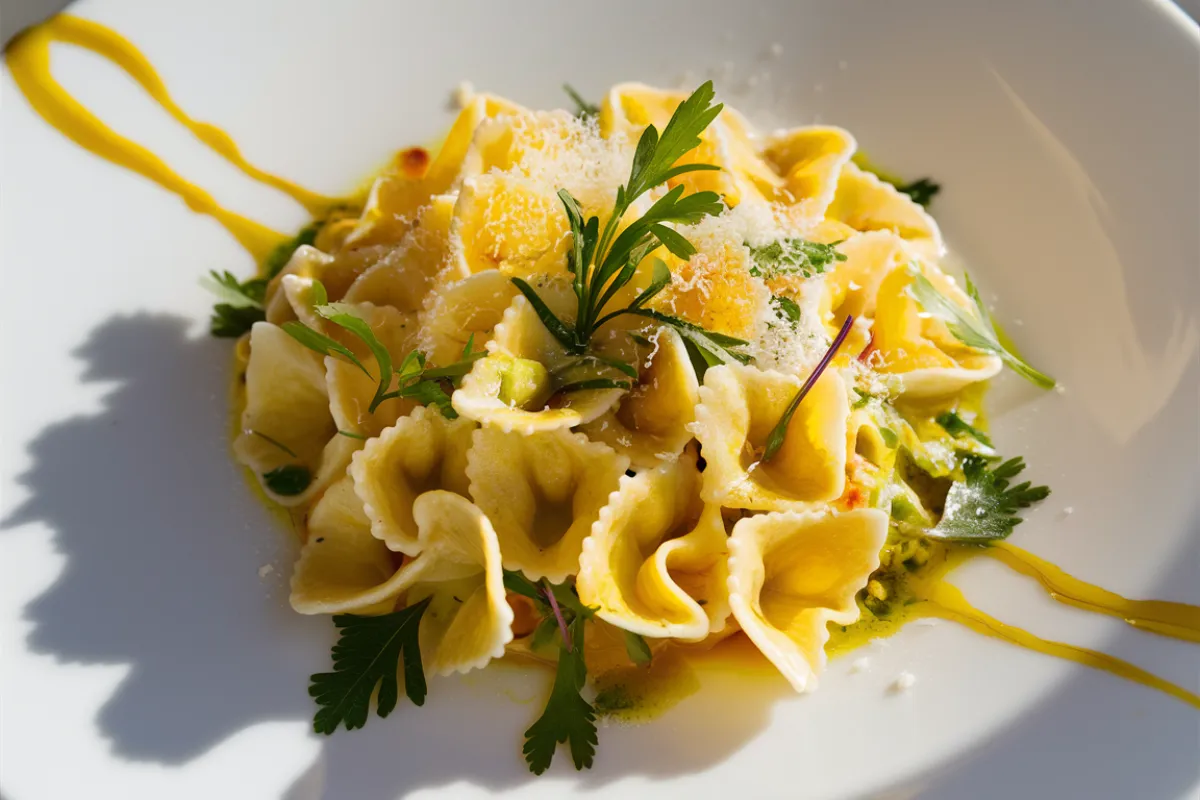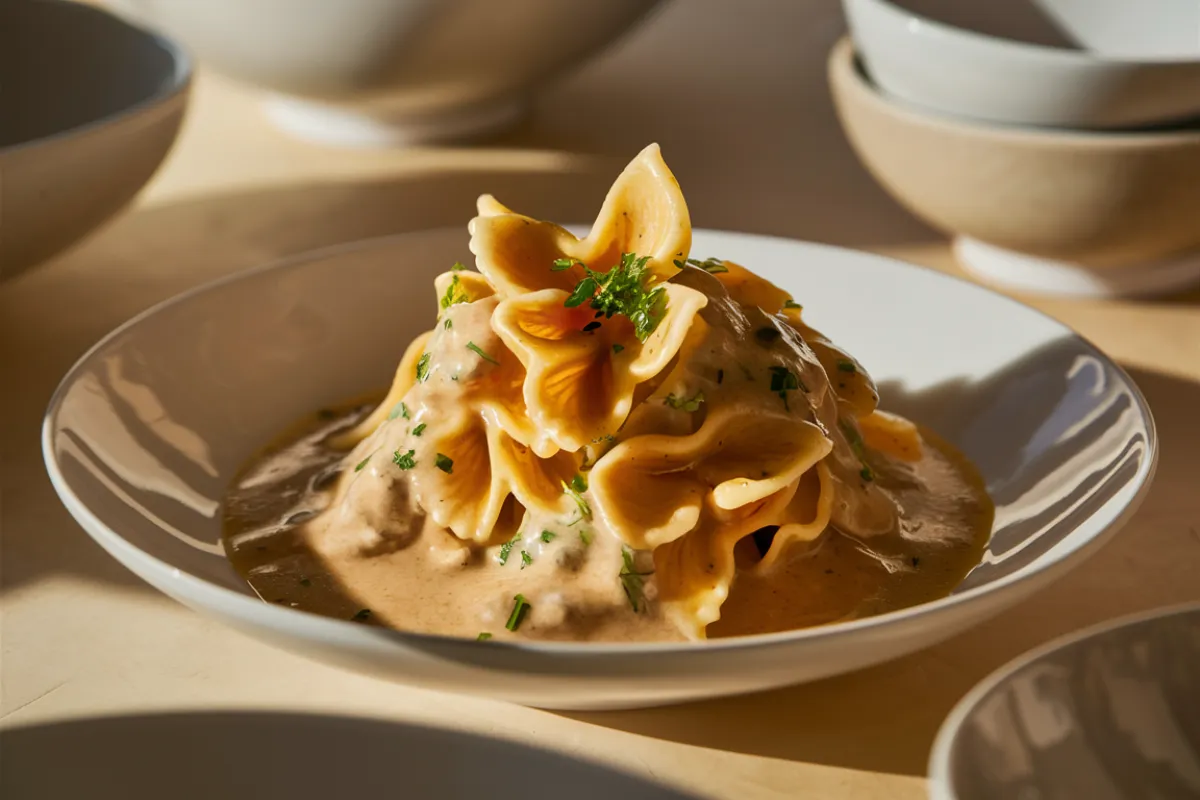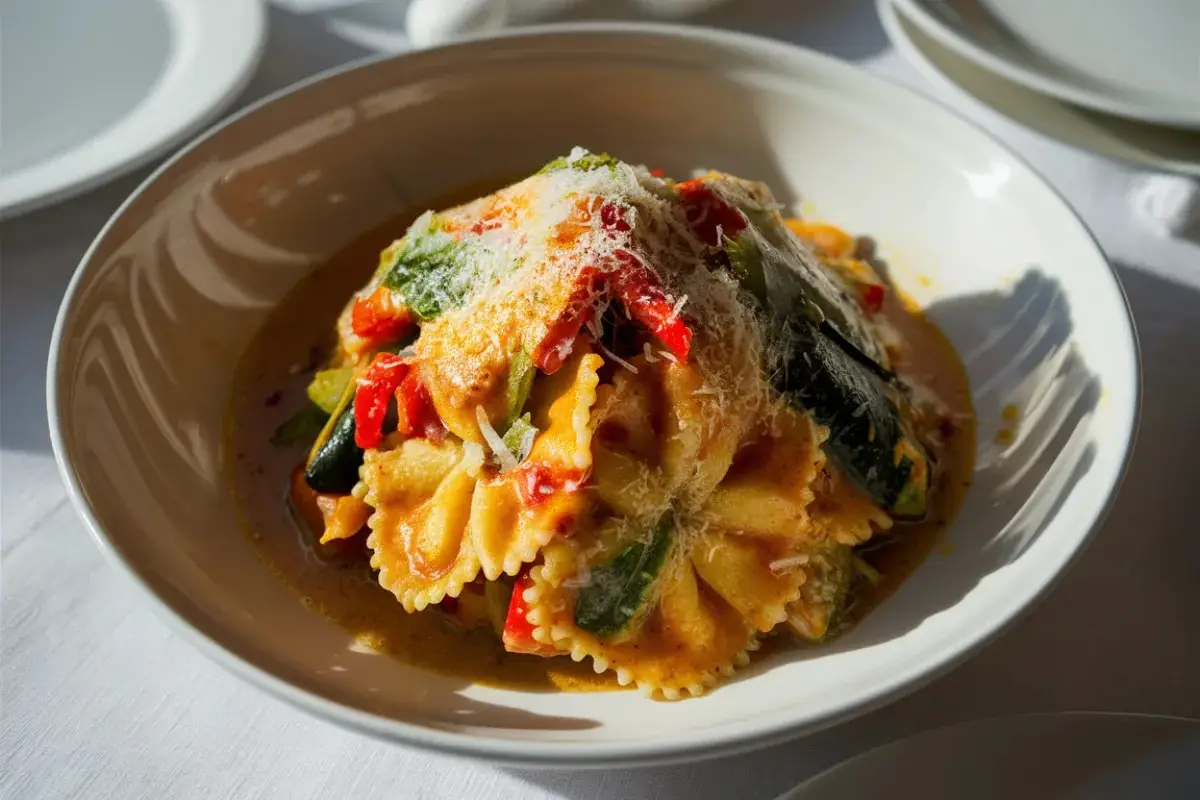Farfalle Pasta, known for its charming bow-tie or butterfly shape, is a favorite in Italian cuisine and beyond. Its unique shape, with pinched centers and ruffled edges, makes it perfect for holding a variety of sauces and ingredients. This adds both texture and visual appeal to dishes. But there’s much more to farfalle than its appearance. Its rich history, diverse applications, and adaptability make it a fascinating subject for any pasta enthusiast.
A Historical Perspective on Farfalle Pasta
The origins of farfalle pasta trace back to the 16th century in Northern Italy, particularly in the regions of Lombardy and Emilia-Romagna. Local housewives, aiming to repurpose leftover pasta dough, began crafting this distinct shape by cutting small rectangles and pinching the centers to create a butterfly-like design. This creative approach to pasta-making not only minimized waste but also gave birth to one of Italy’s most beloved pasta shapes.
The word “farfalle” itself is Italian for “butterflies,” reflecting the light, fluttering shape of the pasta. This playful and charming name, paired with the pasta’s unique appearance, quickly captured the hearts of Italians and spread across Europe. Eventually, it reached kitchens worldwide.
The Different Varieties of Farfalle Pasta

While the traditional farfalle shape is widely recognized, there are several variations that each offer their own unique textures and uses:
- Standard Farfalle: The classic bow-tie shape with pinched centers and ruffled edges. It works well with most sauces, from light tomato-based ones to rich cream sauces.
- Farfalle Rigate: This version has ridges on the surface, which help sauces cling better, enhancing the overall flavor.
- Mini Farfalle (Farfalle Piccole): Smaller in size, these are perfect for soups, stews, and cold pasta salads.
- Colored Farfalle: Made by incorporating natural ingredients such as spinach, beetroot, or squid ink into the dough. These pastas add a vibrant splash of color and subtle flavor variations.
The Art of Making Farfalle Pasta
Traditionally, cooks make farfalle pasta with semolina flour and water, creating a simple yet perfect combination. This produces a durable and flavorful dough. They roll the dough out into thin sheets and cut it into small rectangles, each about 4 cm long. They often crimp the edges to give the pasta its characteristic ruffled appearance. Finally, they pinch the center to form the “bow-tie” shape. If you want to try making your own pasta, check out this guide on how to make fresh pasta.
In modern kitchens, you might find hand-crank pasta machines or electric pasta makers that make the rolling and cutting process quicker and more consistent. However, many still prefer the traditional handmade approach. This method not only maintains authenticity but also allows for subtle variations in texture that enhance the eating experience.
If you’re curious about making your own pasta at home or looking to try new dishes, check out recipes like the Taco Pasta Shells Recipe to see how different shapes and flavors can bring excitement to your meal.
Exploring Popular Farfalle Recipes
Farfalle is highly versatile, lending itself to a multitude of recipes. These range from simple, everyday meals to gourmet creations. Here are some of the most popular ways to enjoy this unique pasta:
- Farfalle with Creamy Alfredo Sauce: Toss farfalle in a smooth, buttery Alfredo sauce for a rich, decadent dish. Top it with freshly grated Parmesan cheese and a sprinkle of parsley. This classic combination represents comfort food at its finest.
- Farfalle with Pesto: A lighter, herbaceous option. Farfalle with pesto combines the pasta with a fragrant basil, pine nut, and Parmesan mixture. This simple yet flavorful dish is perfect for summer dining.
- Farfalle in Tomato Basil Sauce: One of the simplest and most beloved preparations. This dish highlights the fresh, tangy flavors of ripe tomatoes, garlic, and basil. It’s often finished with a drizzle of olive oil and a sprinkling of freshly grated cheese.
- Cold Farfalle Pasta Salad: A refreshing option for warm weather. This salad features cooked farfalle mixed with a variety of fresh vegetables, cheeses, and a tangy vinaigrette dressing. For more ideas on enhancing your pasta salads, see how to jazz up boring pasta for creative ways to add flavor and interest.
- Farfalle with Seafood: This combination often pairs the pasta with ingredients like shrimp, clams, or calamari. The pasta’s shape helps to trap the delicate seafood flavors, making each bite a burst of taste and texture.
Cooking Techniques for Farfalle

To ensure that your farfalle turns out perfectly every time, follow these simple steps:
- Boiling Water with Salt: Always use plenty of water and add a generous amount of salt. This flavors the pasta from within as it cooks.
- Stirring Regularly: Once the pasta is added to boiling water, stir it occasionally. This prevents it from sticking together.
- Testing for Doneness: To achieve the ideal texture, cook the farfalle until it is “al dente,” meaning firm to the bite. Test a piece about a minute before the suggested cooking time on the package.
- Draining and Dressing: After draining, toss the pasta with a bit of olive oil or butter. This keeps it from sticking, especially if you are not serving it immediately. You can also save a little pasta water to add to your sauce later, which helps to thicken and flavor it.
- Serving Temperature: Farfalle can be served hot, straight from the pot, or chilled for cold salads. Its shape allows it to adapt to various recipes and temperatures.
Pairing Farfalle with Ingredients and Sauces
Farfalle’s shape and texture make it suitable for pairing with a wide variety of ingredients and sauces. Here are some ideas to inspire your next meal:
- Cheeses: Farfalle pairs beautifully with hard cheeses like Parmesan and Pecorino Romano, or softer, creamier varieties like Gorgonzola and Ricotta.
- Vegetables: Add a splash of color and flavor with vegetables like cherry tomatoes, zucchini, spinach, or bell peppers. Roasted or grilled vegetables bring a smoky flavor that complements the pasta’s taste.
- Herbs and Spices: Fresh herbs like basil, parsley, thyme, and rosemary add a fragrant aroma and vibrant taste. Spices such as black pepper, red pepper flakes, or nutmeg can enhance the dish’s complexity.
- Sauces: Cream-based sauces, like Alfredo or a cheesy bechamel, cling well to farfalle’s ridged surface. For a lighter option, consider a simple olive oil and garlic sauce or a tangy tomato-based sauce.
For a unique twist on seafood and pasta, explore the Ultimate Guide to Halibut Recipes to find creative combinations of flavors.
Farfalle in International Cuisines
While farfalle is quintessentially Italian, it has found its way into various international cuisines. It adapts well to local flavors and ingredients. Here are a few examples:
- American Cuisine: In the United States, farfalle is often used in pasta salads and casseroles. It pairs well with ingredients like bacon, ranch dressing, and shredded cheese, making it a popular choice for potlucks and family gatherings.
- Asian Cuisine: Some Asian dishes use farfalle as a substitute for noodles. You can stir-fry it with vegetables, tofu, or meats and season it with soy sauce, sesame oil, or chili paste for a spicy twist.
Mediterranean Cuisine: In the Mediterranean region, cooks often combine farfalle with ingredients like olives, feta cheese, sun-dried tomatoes, and fresh herbs. These dishes usually turn out light, healthy, and full of flavor, making them ideal for warm-weather meals.
Farfalle in Regional Italian Dishes

Even within Italy, cooks use farfalle differently in various regions, showcasing the diversity of Italian culinary traditions:
- Lombardy: In its region of origin, cooks often prepare farfalle with butter, sage, and grated Grana Padano cheese. This simple yet rich preparation highlights the pasta’s flavor.
- Emilia-Romagna: Here, chefs might serve farfalle with a ragù made from locally sourced meats, such as pork or veal, slow-cooked with tomatoes, wine, and herbs.
- Southern Italy: In the south, people often pair farfalle with fresh, sun-ripened tomatoes, olives, and capers. It’s also common to serve it with seafood, taking advantage of the region’s coastal bounty.
Creative Uses for Farfalle Beyond Traditional Dishes
While farfalle is delicious in classic pasta dishes, it also has several creative applications:
- Baked Farfalle Casseroles: Mix cooked farfalle with a creamy sauce, vegetables, and a sprinkling of cheese, then bake until golden and bubbly for a comforting, hearty meal.
- Stuffed Peppers with Farfalle: Combine cooked farfalle with ground meat, tomatoes, and spices, then stuff the mixture into bell peppers and bake them for a delightful twist on a traditional stuffed pepper recipe.
Farfalle Frittata: Mix leftover farfalle with eggs, cheese, and herbs, and cook the mixture in a skillet to create a savory pasta frittata that you can enjoy for breakfast, lunch, or dinner.
- Crispy Farfalle Snacks: Fry cooked farfalle until golden and crispy, then season with salt, pepper, and your favorite spices. These make for a crunchy, satisfying snack or appetizer.
Sustainability Considerations for Farfalle Lovers
As consumers become more aware of the environmental impact of their food choices, they show a growing interest in sourcing pasta more sustainably. Many brands now offer organic or whole grain farfalle, which producers often make with more sustainable agricultural practices.
Choosing pasta made locally or from companies committed to sustainability can also help reduce the carbon footprint associated with long-distance food transport. Additionally, making pasta at home allows you to control ingredients, reduce packaging waste, and ensure freshness.
Frequently Asked Questions about Farfalle Pasta
1. What is the best way to cook Farfalle pasta?
Boil in salted water for 10-12 minutes until al dente. Stir occasionally to prevent sticking.
2. Can Farfalle be used in a cold pasta salad?
Yes, farfalle is perfect for cold pasta salads due to its shape, which holds dressings and mixes well with vegetables and proteins.
3. Why is Farfalle called ‘bow-tie’ pasta?
The pasta’s shape resembles a bow-tie or a butterfly, which is why it has these names.
4. Is Farfalle suitable for baked dishes?
Absolutely! It works wonderfully in baked casseroles and pasta bakes.
5. Can Farfalle be made from different flours?
Yes, it can be made from whole wheat flour, gluten-free flours, or even chickpea flour for alternative dietary needs.
Conclusion
Farfalle is not just a charming pasta shape; it’s a canvas for culinary creativity. Its adaptability to various sauces, ingredients, and international flavors makes it a versatile choice for any meal. Whether you’re sticking to traditional Italian recipes or experimenting with global fusion dishes, farfalle brings both taste and visual appeal to your table. So, next time you cook, consider giving this butterfly-shaped pasta a chance to flutter into your favorite dishes!

